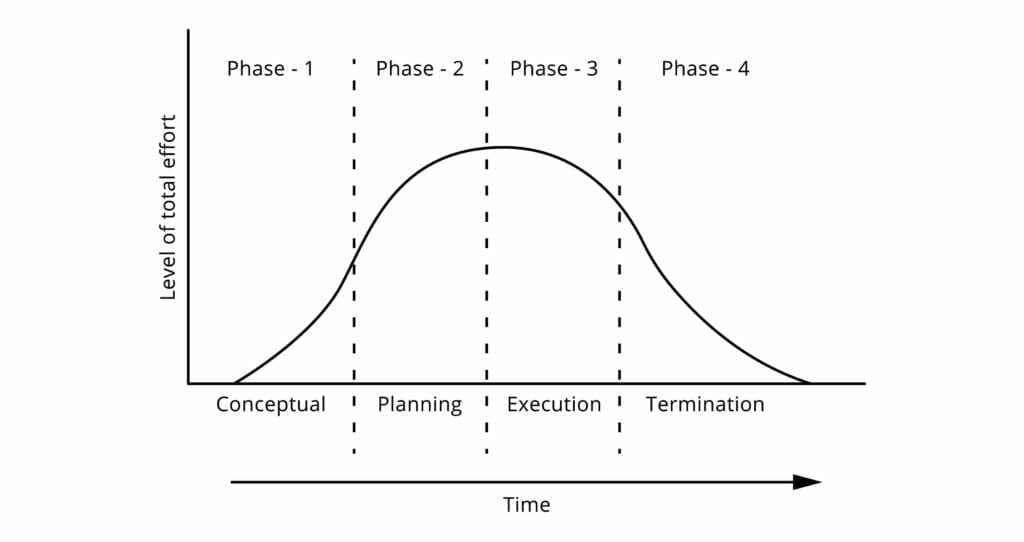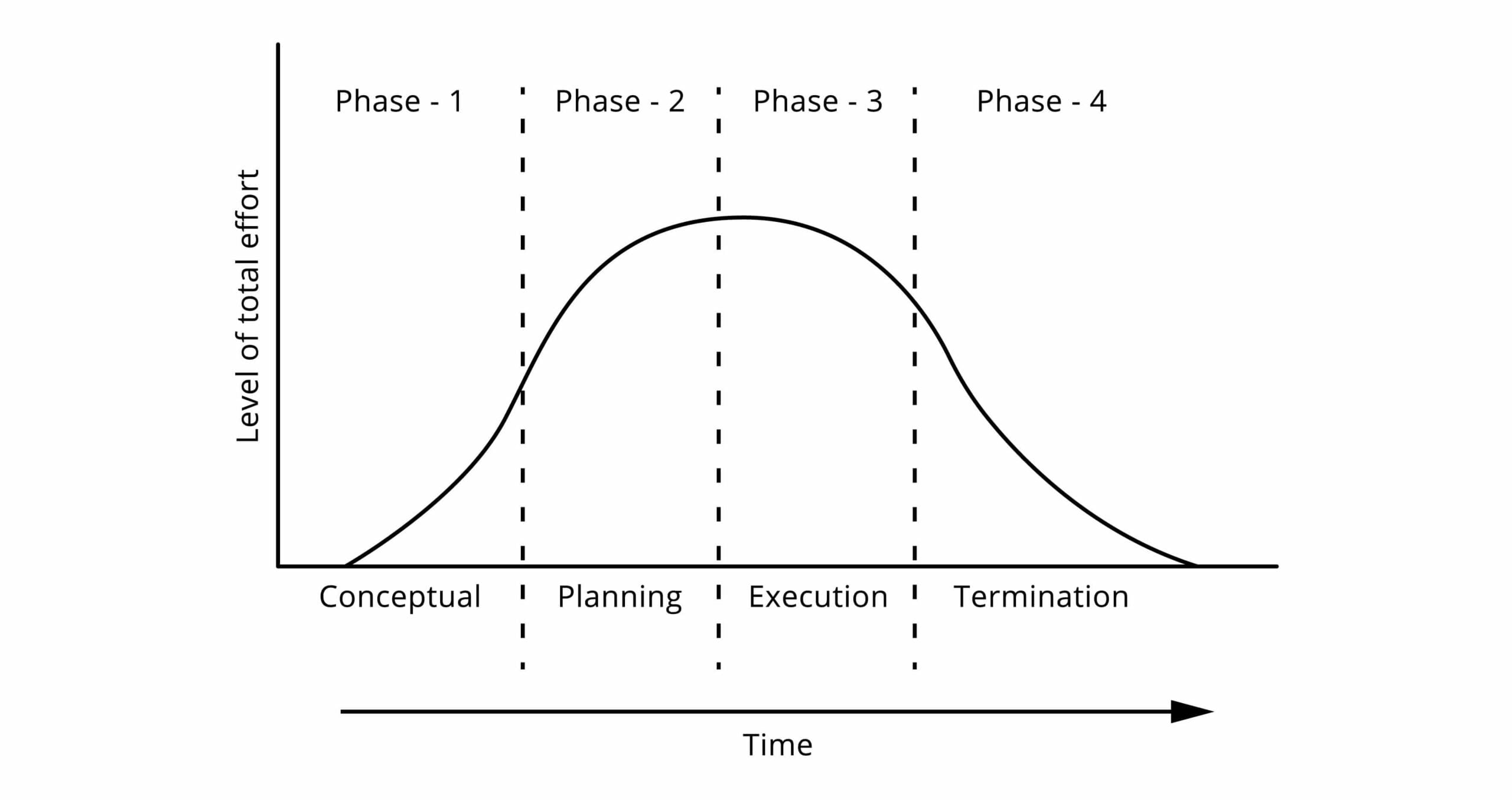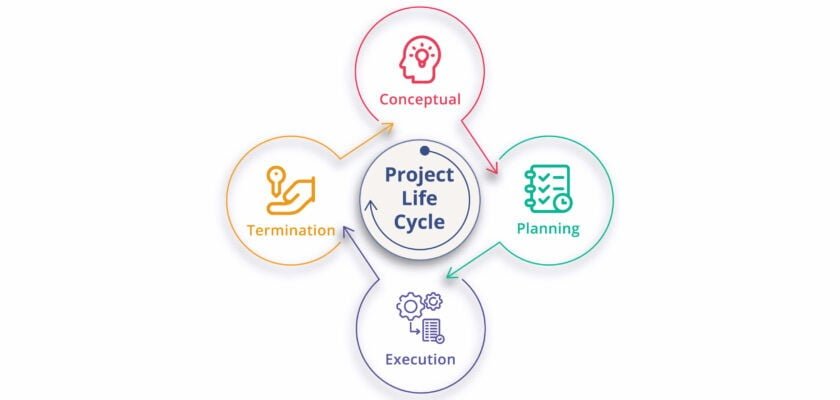A grasp of the project life cycle is vital whether you’re working on a small project with modest commercial goals or a massive, multi-departmental endeavor with far-reaching corporate ramifications. Completing a project successfully is a difficult task. It necessitates a succession of actions in order to fulfill the requirements of stakeholders and clients; there is a lot involved in the process before the project reaches the completion phase. Whatever sort of project you are working on, having a thorough understanding of the Project Management life cycle, project stages, or process groups is crucial. It maintains your ongoing initiatives more structured and feasible from inspiration to conclusion.
In this article, we will explore the concept of the project life cycle, discussing the four phases of project life cycle. We will examine the goals and deliverables of each phase, as well as the key activities and considerations involved in managing a project through its life cycle. By understanding the project life cycle and its four phases, you will be better equipped to plan, execute, and successfully complete projects of all sizes and types.
What is the Project Life Cycle?
A project is performed in different stages from beginning to end, and different types of work are performed in different stages. The steps of the project are related to each other, and the steps are performed in a logical order. The logical sequence of project steps is called Project Cycle. Once the work of one phase of the project cycle is completed, the next phase begins. Most projects follow almost the same steps from start to finish.
In general, the project life cycle is a step-by-step structure of best practices used to guide a project from start to finish. It gives project managers an organized technique to plan, execute, and complete a project.
Stages of Project Life Cycle described by Different Individual
Different individuals and organizations have described project cycles based on their vision. For example, Gray and Larson mentioned four stages in the project’s life cycle. These are – (i) project definition, (ii) plan, (iii) implementation, (iv) transfer. W.C Baum outlines six stages in the life cycle of the project. (i) project identification, (ii) project formulation, (iii) project pricing, (iv) project approval, (v) project implementation and monitoring, (vi) project pricing.
Dennis A. Rondinelli outlines the 12 stages of the project’s life cycle. (i) project identification and definition, (ii) project description, preparation and feasibility analysis, (iii) project design, (iv) project evaluation, (v) project selection, contract and approval, (vi) project activation and organization, (vii) Project implementation and commissioning, (viii) Project supervision, monitoring, and control, (ix) Project completion and termination, (x) Production, distribution and transfer to regular administration, (xi) Project evaluation, (xii) Follow up, analysis And taking action.
Skylark Chadha mentions eight stages in the life cycle of the project. (i) project identification and initiation, (ii) alternative analysis and decision making, (iii) acquisition of knowledge and technology, (iv) organization, (v) planning and design formulation, (vi) setting up and follow-up, (vii) commissioning, ( viii) Review and analysis.
R.D Archibald mentions 6 levels. (i) Project ideas. (ii) definition, (iii) design, (iv) development, (v) application, (vi) completion.
Karger and Murdock mentioned four levels. (i) conceptual step, (ii) structural step, (iii) operational step, (iv) completion step.
Four Phases of Project Life Cycle
There are 4 phases of Project Life cycle for any project. Adam mentions four preliminary stages of a project’s life cycle that apply to all projects and is a general model of a project’s life cycle. The life cycle of the project given by Adam is briefly described below.

- Conceptual: This is the initial stage or first step of the project. In this case, the initial goal of the project is set, and accordingly, the feasibility study is specified. The first step of the project is to determine the scope of work, identify the necessary resources (people, money, equipment) and bring together the people concerned with the project.
- Planning: Planning is a stage where all tasks are assigned to each of the tasks, specifying, listing, indexing, and dividing the work package into smaller units, and the project completion plan is formulated. For example, all the steps (research, thrashing, editing, etc.) in a term paper completion plan are pre-determined.
- Execution: At this level, the actual work of the project is done. Systems are developed or products are created and crafted. Most of the work of the project is carried out at the implementation stage and maximum effort is exerted at this level. The maximum utilization of the manpower and inputs engaged in the work of the project is at the implementation level, as a result of which the cost of the project increases rapidly at this level.
- Termination: The completion of the project is announced when all the work of the project is completed and handed over to the entrepreneur or buyer. This is the last step of the project. At this stage, as all the major and minor projects of the project are completed, the scope of the project shrinks and the cost decreases rapidly. Apart from that, the unused resources and manpower of the project are removed and engaged in any other new project. The end of the project is officially announced by handing over the project to the last project entrepreneur or owner.
From the above discussion, it is clear that every project has a specific life cycle. The life cycle of the project begins and the life cycle of the project ends with the formal completion.
Frequently Asked Questions
1. What are the 4 phases of a project?
Adam mentions four phases of a project life cycle that apply to all projects and is a general model of a project life cycle. The life cycle of the project given by Adam is below:
1. Conceptual
2. Planning
3. Execution
4. Termination

